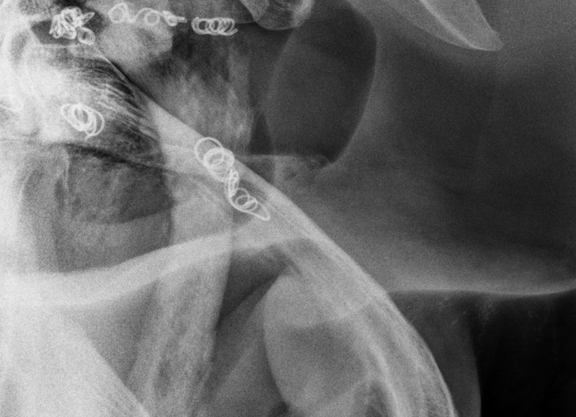By Jen Roytz
The first sign is often a simple trickle of blood dripping down from a horse's nostril. Often dismissed as something as simple as allergies or a broken blood vessel from bumping their head, when the cause is guttural pouch mycosis, the trickle of blood can become a stream and soon a gush in a matter of days, if not hours or minutes.
Guttural pouches are unique to a small number of animals, including horses. Located beneath the ear near the throatlatch on each side of a horse's head, guttural pouches are sacs of air that are lined with a thin membrane and expand from the Eustachian tube. Just beneath the membrane lining run the internal carotid, external carotid and maxillary arteries, which supply blood to a horse's brain and head, as well as nerves associated with the head and throat that control basic functions such as swallowing, facial movements and upper airway reflexes.
Guttural pouch mycosis is a fungal infection of one or both of a horse's guttural pouches commonly caused by the Aspergillus fungus (though can be associated with other fungi) that affects the lining of the guttural pouch by forming plaques that can damage these critical arteries and nerves. These plaques can slowly erode the walls of arteries nerves and causing a life-threatening hemorrhage or significant nerve damage that can impede a horse's ability breathe or swallow properly.
“Fungus is a feeder–it can eat through arteries and nerves, as well as create inflammation around an affected area that can then impact the nerves,” said Nathan Slovis, DVM, Director of the McGee Center at Hagyard Equine Medical Institute and member of the practice. “While many may not be familiar with it, guttural pouch mycosis is not uncommon. It is more prevalent in the Southern U.S., where the warmer temperatures and more humid climate create a more favorable environment for fungus to proliferate, but it can affect horses here in Kentucky and up north as well.”
While often the first reported symptom of a horse with guttural pouch mycosis is bleeding from the nose due to the fungus having eroded through the wall of a blood vessel (the reason I said this is because it can also erode veins and arteries (and a horse may experience multiple minor nose bleeds prior to a fatal hemorrhage), Slovis says there are several other possible symptoms that can suggest an infection of the guttural pouch.
“When you see excessive coughing due to the consistent dorsal displacement of the soft palate, that can be an indication to take a look at the guttural pouches. Other symptoms can include difficulty swallowing, food material coming out of their nose or chronic nasal discharge–not just blood, but mucus–coming out of one nostril,” said Slovis. “The key sign is the mucus or discharge coming out of just one nostril consistently. It is possible for both guttural pouches to become infected, but typically it is just one, whereas horses with pneumonia that present with nasal discharge usually have mucus coming from both nostrils.”
Other less common clinical symptoms of a guttural pouch infection include a drooping eyelid, constricted pupil, a sunken eye, patchy sweating affecting only one side of the neck and irregular head posture.
Guttural pouch mycosis can be diagnosed through an endoscopic exam. Fungal plaques appear overtop of blood vessels and/or nerves as black, tan or white membranes.
If the fungus has not yet compromised the nerves or arteries, Slovis says the condition can be treated medically by lavaging the guttural pouch with antifungal medication and using a topical antifungal on the guttural pouch anywhere from three to seven times a week, depending on the severity.
“The risk with treating the disease medically is that you can't kill the fungus immediately. You have to treat a horse for four to five weeks or more, and during the treatment process the fungus can continue to do harm and cause a bleed or nerve damage,” he said.
Slovis says the preferred method to treat guttural pouch mycosis is to surgically insert a coil or a balloon into the affected blood vessel to quickly cut off the blood supply. If and when the fungus compromises the integrity of the blood vessel, there is no blood supply. Typically, once the blood supply has been removed, the fungus regresses.
“While I prefer to use a coil if we diagnose a patient prior to a hemorrhage, if we receive a horse with guttural pouch mycosis that is already bleeding out, we stabilize the horse and put them on coagulants to clot the blood, then rush them to surgery to perform the embolization with a balloon,” said Slovis. “If the owner cannot afford this type of surgery, we can also try using drugs like Tranexamic Acid, which is also used in human medicine, to clot the blood. This can be dangerous because we know at this point the blood vessel has already been significantly weakened.”
The prognosis and recovery process for horses with guttural pouch mycosis can vary greatly and is dependent on what structures were compromised by the infection. If the fungus affected only an artery, the recovery time can take weeks– possibly more in more severe cases. In horses whose symptoms included nerve damage, more extensive long-term care may be necessary, including the insertion of a feeding tube or performing a tracheostomy to allow the horse to breathe properly.
“Nerve injury is the worst. It's a whole different category as far as recovery goes. It can take several months or even a year, if the horse is able to recover at all,” he said.
Not a subscriber? Click here to sign up for the daily PDF or alerts.






